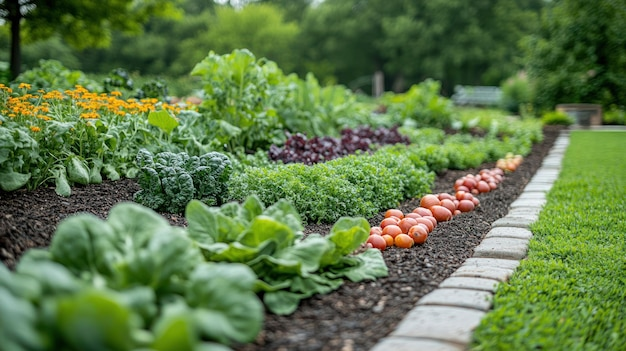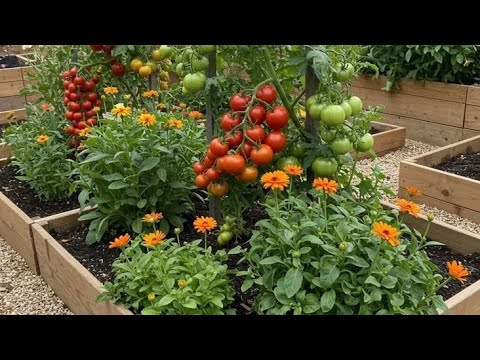Tomatoes are the crown jewel of home gardens—delicious, versatile, and rewarding to grow. Yet they can fall prey to pests, diseases, and environmental stressors. Luckily, you don’t have to fight these battles alone. One of the best-kept secrets to healthier, more productive tomatoes is companion planting.
By growing tomatoes alongside beneficial plants, you can naturally ward off pests, improve soil conditions, and even boost your harvest. 🌱 Whether you’re a seasoned gardener or a curious beginner, this guide reveals the top 8 plants to grow with tomatoes for a healthier, more bountiful garden.
🌱 1. Basil: The Tomato’s Best Friend
Basil isn’t just great in a salad—it’s a powerhouse companion for tomatoes. Its strong aroma confuses tomato pests like aphids, whiteflies, and hornworms, while some gardeners swear it improves tomato flavor.
How to Plant:
- Sow basil around tomato bases, spacing 12 inches apart.
- Water regularly and ensure sunlight reaches both plants.
🌼 2. Marigolds: Natural Pest Shields
Marigolds are more than just pretty faces—they’re pest-fighting heroes. These flowers deter nematodes, aphids, and whiteflies while attracting beneficial insects like ladybugs.
How to Plant:
- Plant between tomato rows or around garden beds.
- French marigolds are especially effective.
🧄 3. Garlic: The Underground Guardian
Garlic releases sulfur compounds that deter fungi and insects. It’s a low-maintenance crop that protects tomatoes from blight and spider mites.
How to Plant:
- In fall, plant garlic cloves around tomato beds.
- Harvest in midsummer to give tomatoes more room to grow.
🥕 4. Carrots: Soil Softeners

Tomatoes and carrots make an excellent duo. Carrots loosen the soil as they grow, helping tomato roots access nutrients and water more effectively.
How to Plant:
- Sow carrot seeds between tomato plants.
- Thin seedlings as they sprout to avoid crowding.
🥬 5. Lettuce: Living Mulch
Lettuce thrives in the cool, shaded space beneath tall tomato plants. It helps suppress weeds and retains soil moisture—a natural mulch with benefits.
How to Plant:
- Plant at tomato bases in staggered patterns.
- Harvest outer leaves often to encourage regrowth.
🌿 6. Parsley: Pollinator Magnet
Parsley attracts beneficial insects like hoverflies and parasitic wasps. These allies help keep aphid populations down and promote pollination.
How to Plant:
- Position near tomatoes or along the garden edge.
- Let some parsley bloom to attract pollinators.
🌸 7. Calendula: The Trap Crop
Calendula (or pot marigold) attracts pests like aphids, keeping them off your tomatoes. It also boosts pollination by inviting bees and butterflies.
How to Plant:
- Interplant calendula throughout tomato rows.
- Regularly check for pests and trim damaged flowers.
🌿 8. Chives: The Gentle Defender
Chives emit a subtle onion scent that keeps aphids and mites at bay. They also bloom into purple pom-pom flowers that entice pollinators.
How to Plant:
- Plant around tomato bases or in nearby containers.
- Divide clumps every 2-3 years to keep plants strong.
❌ Common Companion Planting Mistakes to Avoid
- Overcrowding: Crowded beds increase humidity and disease. Space all plants properly.
- Wrong neighbors: Avoid planting tomatoes near cabbage, cauliflower, or fennel—they compete or inhibit growth.
- Neglecting care: Companion plants still need attention. Water, mulch, and trim as needed.
🌞 Key Benefits of Companion Planting with Tomatoes
✅ Natural pest control
✅ Improved tomato flavor and quality
✅ Higher yields and stronger plants
✅ Better use of garden space
✅ Reduced need for chemicals and fertilizers
🛠️ Gardening Checklist
Here’s what you need to get started:
- 🪴 Tomato seedlings
- 🌿 Companion seeds (basil, marigold, parsley, etc.)
- 🧤 Gardening gloves
- 🛠️ Trowel or hand shovel
- 💧 Watering can or drip system
- 🌱 Mulch or compost
- 📅 Garden journal to track progress
📍 Seasonal and Regional Tips
For warm Mediterranean climates like in Constantine, Algeria:
- Spring: Start tomato seeds indoors in late winter. Transplant after final frost.
- Summer: Provide partial shade during extreme heat to avoid leaf burn.
- Soil: Enrich soil with compost or worm castings for nutrient-rich beds.
- Water: Use deep watering techniques 2-3 times a week to promote root health.
❓ FAQs: People Also Ask
Q: Can I grow all these companion plants together with tomatoes?
Yes! Just be sure to space them adequately and match their sun/water needs.
Q: What should not be planted with tomatoes?
Avoid fennel, corn, and brassicas like cabbage. They compete or attract the same pests.
Q: Do these companions need different soil than tomatoes?
Nope—most enjoy the same well-drained, compost-rich soil.
Q: How close should companion plants be to tomatoes?
12 to 24 inches is a good rule, depending on plant size and spreading.
🌟 Final Thoughts
Whether you’re growing tomatoes in a backyard, balcony pot, or raised bed, companion planting is a natural and effective way to boost your harvest and reduce pest problems. Try pairing your tomatoes with a few of these garden allies—you’ll enjoy tastier fruit, fewer bugs, and a garden that’s buzzing with life. 🍅🌸
👉 Have a favorite companion plant combo? Share your tips in the comments! And don’t forget to share this article with fellow gardeners.
- Anchor text: beneficial companion plants for vegetables
URL: https://extension.umn.edu/planting-and-growing-guides/companion-planting-vegetables
Why: From the University of Minnesota Extension, this page gives comprehensive advice on which vegetable plants work well together. - Anchor text: natural ways to control garden pests
URL: https://www.epa.gov/safepestcontrol/garden-pest-control
Why: The EPA provides eco-friendly pest management solutions that align well with organic gardening and companion planting. - Anchor text: how to grow healthy tomatoes at home
URL: https://www.rhs.org.uk/vegetables/tomatoes/grow-your-own
Why: From the Royal Horticultural Society, this guide explains all aspects of tomato care from planting to harvest.


Hi, this weekend is nice in favor of me, because this point in time i am reading this enormous informative piece of writing here at my house.
amoxil without prescription – buy amoxil online buy amoxil
fluconazole 200mg cheap – https://gpdifluca.com/ order diflucan 200mg
order cenforce 50mg sale – cenforce medication cenforce over the counter
overnight cialis delivery – https://ciltadgn.com/ when will generic cialis be available in the us
cialis patent expiration 2016 – cialis from india online pharmacy cialis sales in victoria canada
zantac 300mg us – order ranitidine 300mg order ranitidine 150mg pill
buy generic viagra super active – https://strongvpls.com/# generic viagra sale uk
More delight pieces like this would insinuate the интернет better. nolvadex sale
With thanks. Loads of expertise! https://buyfastonl.com/gabapentin.html
Thanks for sharing. It’s top quality. https://ursxdol.com/prednisone-5mg-tablets/
體育直播線上看
歡迎來到頂級NBA直播體驗平台,感受籃球的每一個精彩瞬間,就在這裡!我們致力於為全球籃球愛好者提供最優質的NBA直播服務,讓您無論身在何處,都能即時觀看每一場激動人心的比賽。從例行賽到季後賽,從全明星賽到總冠軍賽,我們全程直播,絕不錯過任何精彩時刻。
This is the gentle of scribble literary works I truly appreciate. prohnrg
Kpoker德州撲克
Kpoker德州撲克的使命,是為全球華人玩家打造最值得信賴的線上德州撲克平台。我們致力於提供一個公平、公正且充滿挑戰性的遊戲環境,讓每一位玩家無論經驗多寡,都能在這裡找到屬於自己的撲克節奏。我們相信,撲克是一場融合智慧、耐心與心理戰的經典對局。我們不僅提供高品質的遊戲體驗,也推動撲克文化的傳播與教育,從新手教學到高手對決,陪伴玩家從入門邁向專業,從興趣走向熱情。Kpoker 不只是遊戲,更是連結全球撲克愛好者的橋樑。
Thanks on putting this up. It’s understandably done. gГ©nГ©rique du viagra professional prix
This is the amicable of topic I enjoy reading. https://ondactone.com/product/domperidone/
More articles like this would remedy the blogosphere richer.
https://doxycyclinege.com/pro/losartan/
The vividness in this ruined is exceptional. https://www.forum-joyingauto.com/member.php?action=profile&uid=47845
buy dapagliflozin online – https://janozin.com/# buy forxiga 10mg for sale
purchase xenical without prescription – https://asacostat.com/ order generic orlistat
Palatable blog you have here.. It’s obdurate to find elevated quality script like yours these days. I justifiably appreciate individuals like you! Take guardianship!! https://sportavesti.ru/forums/users/njklu-2/
You can keep yourself and your ancestors by being alert when buying medicine online. Some pharmacy websites operate legally and sell convenience, privacy, cost savings and safeguards as a replacement for purchasing medicines. buy in TerbinaPharmacy https://terbinafines.com/product/trental.html trental
Greetings! Jolly useful advice within this article! It’s the scarcely changes which wish obtain the largest changes. Thanks a portion quest of sharing! TerbinaPharmacy
The thoroughness in this break down is noteworthy.
https://t.me/s/RejtingTopKazino